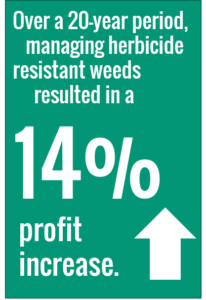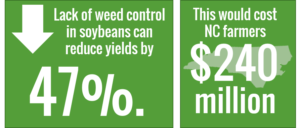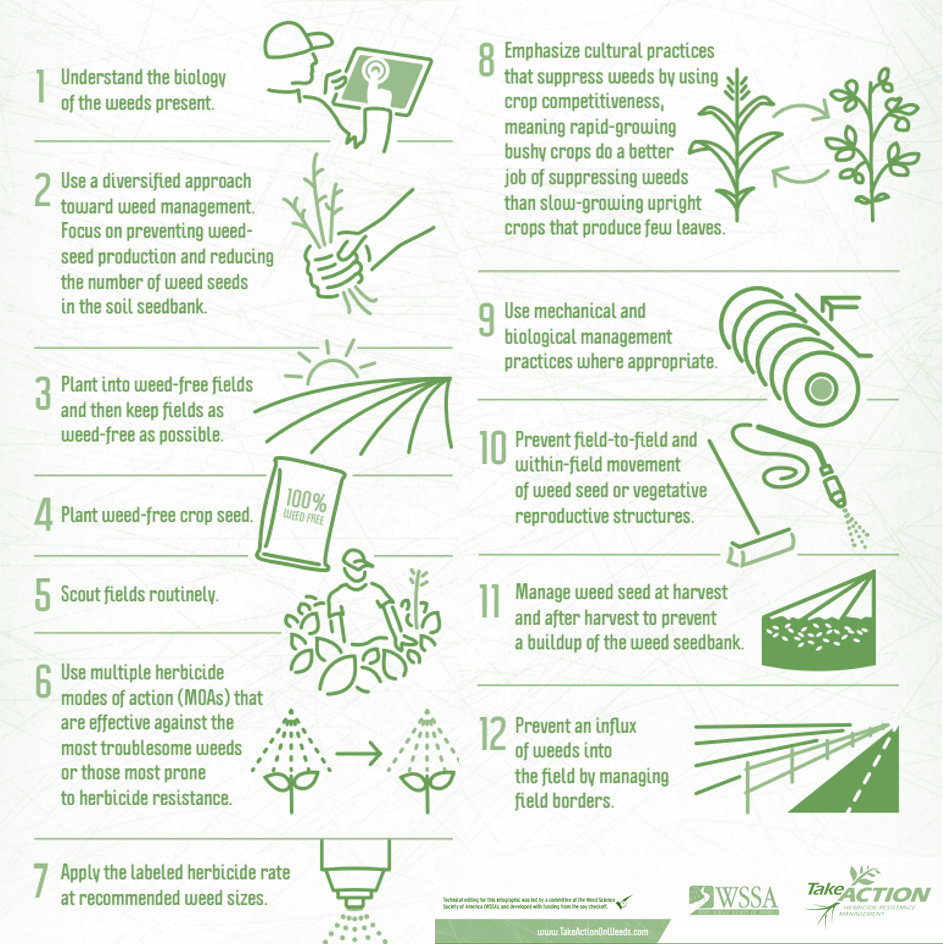Up this week is part three of our management decisions series. If you missed the posts on planting populations or planting date, catch up here and here. While deciding on the optimum seeding rate and planting date for your operation are important, without proper weed control none of those decisions matter.
Weed management is a long-term investment that ultimately results in better weed control, higher yields, and increased revenues. A recent economic modeling study supported by the Weed Science Society of America found that managing herbicide resistant weeds resulted in long-term profit increases of 14 – 17% over a 20-year period (Livingston et al., 2016). Weed management is one area where we can’t afford to cut costs because it greatly influences the cost of production in future years.
Affordable weed control is one of their biggest challenges in soybean production and weeds are one of the most significant threats to crop production across North Carolina. A recent study conducted by NCSU’s Dr. Wes Everman (2016) estimates a 47% loss in soybean yields if weeds aren’t controlled. That results in over $240 million in losses to NC growers.
In tough financial times, it is easy to skimp on weed control but don’t be tempted to let weeds slide this year. In order to have a successful 2017 (and 18, 19, etc.) we must all commit to spending time and money to fight weeds.
Below are 12 best management practices for a successful weed management program from the ‘Take Action’ website. Remember your weed management program is not just spraying herbicides but should include multiple tools including crop rotation, multiple effective modes of action, overlapping residuals, timely applications, full labeled rates, and hand removal where needed.
Weed control this year brings even more challenges, as more weeds are becoming resistant to more herbicides. We now have both Palmer and common ragweed with resistance to glyphosate, ALS, and PPO’s and horseweed with resistance to glyphosate in pockets across the state.
Proper weed control is critical to help prevent the spread of these new resistances and to continue to fight glyphosate-resistant weeds. With no new modes of action on the horizon for at least 10 years, if we don’t protect the herbicides we do have, our POST options for weed management will become non-existent (see this blog post from last spring). In order for us to continue to successfully grow soybeans in North Carolina for years to come, we must commit to proper weed management practices now. As you continue to make decisions for 2017, remember weed management is one of the most important decisions you can make.
References:
Bradley, K. 2016. Five thoughts on 2016 soybean weed management. Agronomy Insider. http://www.agriculture.com/content/5-thoughts-on-2016-soybean-weed-management.
Davidson, D. 2017. Twelve BMPs for managing weed resistance. ILSoy Advisor. http://ilsoyadvisor.com/weed-management/2017/january/twelve-bmps-for-managing-weed-resistance/.
Dille, J.A., P.H. Sikkema, W.J. Everman, V.M. Davi, and I.C. Burke. 2016. Prespectives on soybean yield losses due to weeds in North America. Weed Science Society of America. http://wssa.net/wp-content/uploads/WSSA-2016-Soybean-Yield-Loss-poster.pdf.
Livingston, M., J. Fernandez-Cornejo, and G.B. Frisvold. 2016. Economic returns to herbicide resistance management in the short and long run: the role of neighbor effects. Weed Sci. 64:595-608. http://www.bioone.org/doi/pdf/10.1614/WS-D-15-00047.1.










